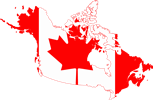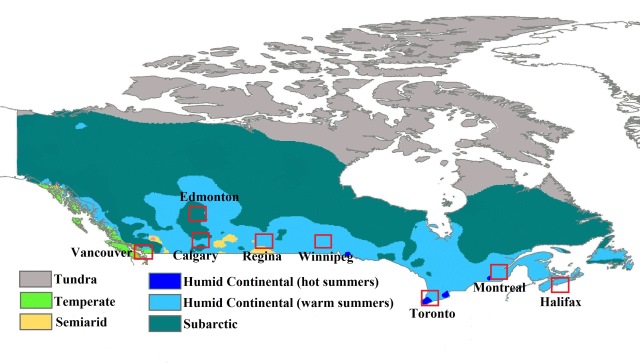
About Canada

Canada is known for its beautiful scenery, Ice Hockey, the Mounties and Ryan Gosling but what else do we know about Canada, apart from it being not only one of the wealthiest countries in the world but also a country with one of the highest standards of living on the planet.
Where is Canada?
Canada is the Northern part of the continent of North America. It is a vast country reaching the Arctic Ocean to the north and the United States of America to the south. The Canadian/US border is the longest land border in the world shared by two countries. Canada extends east to west from the Atlantic Ocean to the Pacific Ocean Canada has ten provinces: Ontario Quebec Nova Scotia New Brunswick Manitoba British Columbia Prince Edward Island Saskatchewan Alberta Newfoundland & Labrador And three territories North West Territories Yukon NunavutHow big is Canada?
The total area of Canada is 9.98 million square kilometers which makes Canada the second largest country in the world after Russia. Put into perspective, the UK can fit into Canada 41 time and Taiwan about 277 times.What is the population of Canada?
The 2014 estimate for the population of Canada is 35,344,962. In 2006 31% of the population classed themselves as Canadians followed by: English 21% French 15.8% Scottish 15.1% Irish 13.9% German 10.2% Italian 4.6% Chinese 4.3% First Nation 4.0% Ukrainian 3.8% Dutch 3.3%Where do the people live?
The vast majority of Canadians, about 95% of the population, live less than 100 miles from the border with the United States. The main population concentrations are Toronto, Ontario (5.5 million), Montreal, Quebec (3.8 million) and Vancouver, British Columbia (2.3 million). Ottawa- Gatineau, Calgary and Edmonton are the only other cities with populations over 1 million Above the 55th parallel north, the rest of the vast expanse of Canada is sparsely populated by mostly native aboriginal people that have been living in what is now Canada for over 25,000 years.What language do they speak in Canada?
There are two official languages in Canada, English, first language to 59.7% of the population and French which is first language to 23.2% of the population. There are eleven aboriginal languages with over 65 regional dialects. Chinese (mostly Cantonese) is listed as being spoken by over 1 million people as a first languageHow was Canada formed?
The first known European colonization attempt was around 1000 AD when Norsemen briefly settled in the northern tip of Newfoundland. However it was centuries later when, on behalf England, the Italian John Cabot explored the Canadian Atlantic coast in 1497. In 1534 Jacques Cartier explored the St Lawrence River and claimed the territory for France. 1553 saw Sir Humphrey Gilbert claim St John’s, Newfoundland as the first English colony. French explorer Samuel De Champlain established the first permanent European settlements at Port Royal, in what is now Nova Scotia, in 1605 and Quebec City in 1608. In 1610, the English then established settlements in Newfoundland. After the Seven Years’ War – 1754 – 1763, New France was ceded to Britain. Mainland Nova Scotia had already been ceded in 1713 but in 1763 Britain annexed Cape Breton Island to Nova Scotia and St John’s Island (Now Prince Edward Island). In 1791, to accommodate English speaking loyalists in Quebec, the province was divided in to Upper Canada (now Quebec) and Lower Canada (now Ontario) After the War of 1812 between Britain and the United States there was mass immigration to Canada from Britain and Ireland and the two Canadas were merged to form a united Province of Canada. The end of the Oregon boundary dispute with the USA in 1846 paved the way for the opening of new British colonies of Vancouver Island in 1849 and British Columbia in 1858. 1867 saw the four original provinces, Ontario, Quebec, Nova Scotia and New Brunswick proclaimed the Canadian Federation. The new province of Manitoba joined in 1870 and British Columbia and Vancouver Island (united in 1886) joined in 1871. Prince Edward Island joined the federation in 1873, the last two provinces to join were Alberta and Saskatchewan in 1905. Canada Joined the League of Nations in 1919 independent from Britain but full independence was finally affirmed in 1931.Who is the head of state?
Queen Elizabeth II is the head of state as Canada is member of the commonwealth, a group of countries that were once part of the British Empire. The head of the government is the prime minister, currently Stephen Harper, the leader of the conservative party.What is the weather like in Canada?
Canada is a vast country, the second largest in the world, so to explain Canadian weather in one easy statement is difficult. Because of the massive size of the country, there are six major climate zones but as most of the towns and cities are within one hundred miles from the border with the United States, you won’t have to worry about living in the icy conditions of Canada’s Subarctic and Tundra regions.What are the main climates in Canada?
Semiarid – In Canada, this climate features dry, hot summers and cold winters when it will often snow. Found a few hundred miles east of Vancouver, there are no major Canadian cities in this zone. Temperate Maritime– Vancouver and the coast of British Columbia enjoy this climate. The summers are mild but you are going to see more rain here in the winter rather than the snow you would find in the rest of the country. Humid Continental – Stretching from coast to coast along the southern most parts of Canada, this climate is typified by cold winters and mild summers (light blue) or cold winters and hot summers (dark blue), Toronto experiences the latter of these two climates. Subarctic – Long, very cold winters, and short, cool to mild summers. This climate zone stretches right across central Canada from the Pacific to the Atlantic coast and is only sparsely populated by Canada’s indigenous peoples. Tundra – Found in the very northern parts of Canada where it is winter almost all year round. Not much will grow in this climate because of the severely low temperatures and short growing season. Only the hardiest of Canada’s indigenous population can found living in this climate.Climate map of Canada

Average temperatures in major Canadian cities





